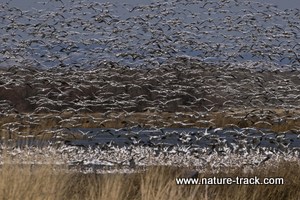Wildlife Management Areas are Idaho Gems

Scenes of abundant wildlife like these snow geese on Market Lake Wildlife Management Area, are not a matter of chance. Wildlife Management Areas are carefully selected for their habitat values.
I watched until dark as tens of thousands of ducks, geese and trumpeter swans ravaged a cornfield.
It was magical to see the ground swarming in a dizzy mass of wildlife. Without warning, huge masses would take wing in a breathtaking blur, circle against the coral-colored sky and settle back down. Had this been a privately owned field, I would have felt dread, not awe. But this wasn't a private field, it was Deer Parks Management Area, and the waterfowl were welcome to feed on corn grown specifically for them.
Like a necklace of precious stones, Idaho's wildlife management areas form a graceful arc from Boundary County to Fremont County. There are 32 state-owned management areas. They represent about one half of one percent of Idaho's 53.5 million acres, but they are critical to wildlife and to hunters and other wildlife enthusiasts.
Wildlife management areas aren't haphazardly selected. A joint study between the University of Idaho and The Nature Conservancy revealed that this complex of properties provide at least some habitat for 97 percent of the biodiversity of plant and animal life in Idaho. They are places where wildlife is welcome, not just tolerated as a necessary evil, and they are strategically located to maximize habitat.
Wildlife management areas play integral roles on regional, national and international scales. Besides providing habitat for locally produced wildlife, places like Market Lake, Deer Parks, Sand Creek, Boundary Creek and Hagerman provide essential habitat for migratory birds. They are stepping stones that the birds must have in order to complete their migration that may begin in Canada and end in Mexico.
They are also important to big game. Big game winter range is the spout of a funnel. As winter approaches, animals pour in from a huge landscape, concentrating on very small pieces of real estate where temperatures and snow depth are more favorable for survival. Wildlife management areas such as Boise River, Craig Mountain, Andrus and Tex Creek, provide winter range for tens of thousands of big game animals. Winter range provided by wildlife management areas is an increasingly valuable commodity as development and competing land uses continue to squeeze bighorn sheep, deer, elk, moose and pronghorn antelope out of other areas.
Some wildlife management areas dedicated to providing winter range may not produce a lot of big game animals, but without the winter range they provide, there would be far fewer animals in vastly larger landscape.
Wildlife management areas differ from other properties in several ways:
· They are managed by Idaho Department of Fish and Game specifically for wildlife. National Wildlife Refuges such as Deer Flat, Kootenai, Bear Lake, Minidoka and Camas are managed by the United States Fish and Wildlife Service.
· Idaho Department of Fish and Game pays fees to the counties in lieu of property taxes on all its properties.
· No state general fund money is used to pay for the management areas. Funding comes from hunting licenses, excise taxes on firearms and mitigation from federal projects, such as Palisades Reservoir.
· Most are woefully underfunded.
Wildlife management areas support the wildlife of the state of Idaho and are also essential for providing the quality of life Idahoans expect. These gems are hardworking pieces of real estate.
Goodreads Book Giveaway
The Best of Nature
by Terry R. Thomas
Giveaway ends June 24, 2014.
See the giveaway details at Goodreads.

"WOW. What a phenomenal piece you wrote. You are amazing." Jennifer Jackson
That is embarrassing, but actually a fairly typical response to my nature essays. Since The Best of Nature is created from the very best of 16 years of these nature essays published weekly in the Idaho Falls Post Register (online readership 70,000), it is a fine read. It covers a wide variety of topics including humorous glimpses of nature, philosophy, natural history, and conservation. Readers praise the style, breadth of subject matter and my ability to communicate complex and emotional topics in a relaxed and understandable manner.
Everyone can find something to love in this book. From teenagers to octogenarians, from the coffee shop to the school room, these nature essays are widely read and enjoyed.
Some of the essays here are my personal favorites, others seemed to strike a chord with readers. Most have an important message or lesson that will resonate with you. They are written with a goal to simultaneously entertain and educate about the wonderful workings of nature. Some will make you laugh out loud and others will bring a tear to the eye and warm your heart.
Readers Write:
"You hit a home run with your article on, Big Questions in Nature. It should be required reading for everyone who has lost touch with nature...great job!" Joe Chapman
"We enjoyed your column, Bloom Where Planted. Some of the best writing yet. The Post Register is fortunate to have your weekly columns." Lou Griffin.
To read more and to order a copy, click here or get the Kindle version
Copies are also available at:
Post Register
Island Park Builders Supply (upstairs)
Barnes and Noble in Idaho Falls
Harriman State Park, Island Park
Museum of Idaho
Valley Books, Jackson Wyoming
Avocet Corner Bookstore, Bear River National Wildlife Refuge, Brigham City, Utah
Craters of the Moon National Monument Bookstore, Arco, Idaho
